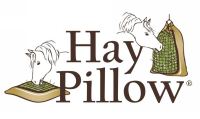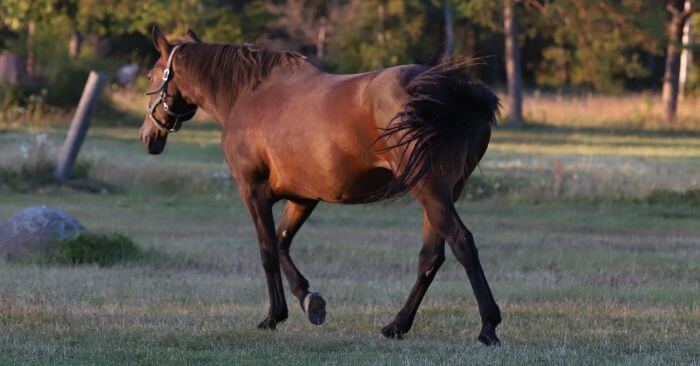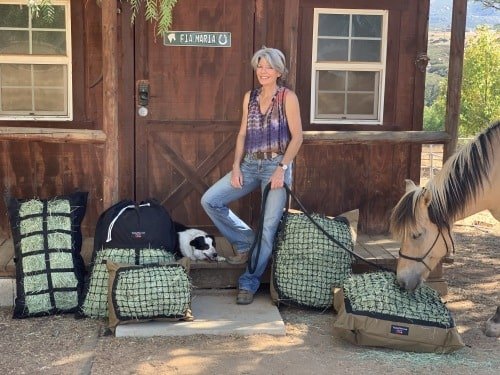Frequently Overlooked Causes of Hay Belly in Horses & Solutions
Hay belly is a common term used to describe an equine with a distended abdomen. A distended abdomen can be a symptom of either physical or dietary causes – or both – and merits attention. A hay belly, in and of itself, is not an indication your horse is fat.
I receive calls from folks who are reluctant to feed more naturally because they worry their horse will get a hay belly. I also have numerous customers who report that their horse’s hay belly went away after transitioning to slow feeding.
Read on to learn more about the most common causes of a hay belly, prevention tactics, and solutions.
Common Causes of Hay Belly in Horses with Solutions
1. Eating Too Fast
How quickly your horse eats and how often you feed affects both his digestion and populations of beneficial microorganisms in the hindgut.
Feeding meals of hay (breakfast and dinner) - which horses can consume too quickly - results in:
- Large amounts of dry matter lacking sufficient saliva-to-forage ratio
- Large particle sizes from not chewing long enough to better prepare hay for the digestive tract, which causes gas and bloating.
The crucial and initial stages of digestion by gastric acid are not fully realized if feedstuff exits quickly. Once the stomach becomes two-thirds full it begins to empty regardless of how well the particles are prepared to advance to the small intestine.
Solution:
Consider slow-fed free choice forage to eliminate food anxiety, increase chew time, and promote further reduction of particle size. Chewing activates saliva production, which provides moisture and aids in digestion. Longer chew time per pound results in smaller particle sizes and a higher saliva-to-forage ratio.
2. Poor Dentition
Any condition causing pain can discourage the required chew time necessary to break down fiber into small enough particles to properly prepare it for digestion. Impaired chew time per bite can cause excessive fluid and gas, which can manifest as a hay belly. Optimal mastication (grinding) requires pain-free unobstructed motion of the jaw.
Solution:
Perform routine dental exams at all ages for retained caps, lost and/or broken teeth, abnormal or uneven bite planes, infected teeth and/or gums, periodontal disease, and hooks - which are sharp protrusions of teeth that can penetrate the opposing gum.

3. Lack of Protein and Proper Nutrition
Malnutrition can cause a dull hair coat, muscle loss including a weak back and abdominal muscles, among other detrimental health challenges. No equine is immune to being malnourished, including overweight individuals.
Solution:
Feed a healthy balanced diet that provides adequate nutrients (water, fats, carbohydrates, protein, vitamins, and minerals). Test your hay or pasture. Testing is the only way to know the nutritional values (including protein content) – and allows you to compensate for deficiencies, imbalances (ratios), and possible excessive components. Consult an equine nutritionist.

4. Sudden Change in Forage
The beneficial array of microorganisms in the hindgut are diet specific. The population can be disrupted easily with an abrupt change in forage. This causes an inability to efficiently break down and digest feedstuff, which results in bloating.
Solution:
Begin by blending small amounts of a new load of hay with your current hay, and increase the percentage over time. If transitioning from pasture to hay or vice versa, slowly increase or decrease pasture time.
5. Inability to Maintain Healthy Microorganism Populations
Key to healthy digestion, microorganism populations can be adversely affected by a variety of factors - including but not limited to - fasting, age, stress, medications, chronic pain, acidic hindgut, rigorous training, transport and environment (suppression of natural instincts).
Solution:
Address the above factors and provide daily prebiotic/probiotic supplementation.
Additional Causes of a Distended Abdomen
Gastric Ulcers
Gastric ulcers can cause bloating and gas.
Solution:
Treat with appropriate therapies, offer free choice forage, avoid high sugar starch feeds, and address all mental and physical stressors.
Parasites
Parasites interfere with nutrient absorption and disrupt the microorganism population of the digestive tract, which can cause inflammation and a distended abdomen.
Solution:
Practice routine parasite control. Be aware that fecal flotation tests are not capable of revealing accurate parasite burdens. Consult your veterinarian for a comprehensive routine parasite control plan.
Uncontrolled Cushing's Disease (PPID)
Muscle loss is associated with Cushing's, including the topline (back muscles) and sagging underline (abdominal muscles).
Solution:
Implement a natural therapy or drug to control hormonal output, feed a balanced low-sugar starch diet, and schedule routine exercise.
With any of these causes, if you are concerned about your horse’s health, it’s best to consult your veterinarian for advice.
How Generic Hay Belly Recommendations Fail
Horses are designed to thrive on high fiber forages. Yet, high fiber mature grass hay or pasture is typically blamed for hay bellies. The most common recommendation for hay bellies is to feed a soft/immature cutting of hay - without determining the underlying cause.
Beyond missing the potential cause, simply feeding immature cuttings as a sole source of forage can be challenging because they:
- Are higher in digestible energy per pound
- Are highly palatable (not always a good thing)
- Require less chew time
- Are lower in fiber and gut fill
- Are rarely safe to offer free choice as their high palatability and calorie count often lead to weight gain
How Slow Fed, Low Sugar Mature Grass Hay Helps
The equine digestive tract depends on a slow, steady flow of fiber to maintain a healthy microorganism population, optimum pH levels, achieve satiation, and promote gut motility.
Mature grass hay – being higher in fiber and lower in digestible energy per pound than immature cuttings – offers a host of helpful benefits to your horse. It’s also an effective alternative to feeding meals when offered free choice via slow feeders to:
- Manage weight (gain or loss)
- Increase chew time
- Sustain optimal pH levels
- Discourage boredom and resulting stereotypies
- Increase insulin sensitivity
- Regulate metabolism
- Reduce colic occurrences
- Maintain healthy microbial populations
- Discourage sand accumulation
Depending on your hay test results, to achieve adequate protein in the diet, you may need to supplement your low sugar mature grass hay or pasture with limited amounts of an immature cutting of grass hay, alfalfa, or a protein rich concentrated supplement.
To Conclude
Hay bellies can be a symptom of one or multiple underlying causes. Explore all potential physical and nutritional possibilities that can cause a distended abdomen. Although feeding an immature, easily digested hay, pellets, cubes or chaff may mitigate a hay belly, the underlying cause likely remains undetermined. Mature grass hay and pasture get a bad rap when it comes to hay bellies, despite the numerous mental and physical benefits covered above.
Helpful Resources
- How & Where to Test Your Horse's Hay & Interpret Results
- Equine Gut Health - The Need for Feed
- Can Horses Eat More Hay Without Weight Gain? The Surprising Factors
- Slow Feeding - Tips & Techniques
- Sand Colic - The Surprising (Simple) Cure & Prevention
- A Safer Always Have Hay Source – Mature Grass Hay
- Healthy Gradual Weight Loss for Horses vs. Fasting & Forage Restriction
References
- Van Niekerk, T. (2021, July 4). How to Choose the Right Hay for Your Horse [7-Step Guide].Retrieved from https://madbarn.com/how-to-choose-hay-for-your-horse/
- Kauter, A., Epping, L.,2 Semmler, T., Antao, E., Kannapin, D., Sabita D., Stoeckle, S., Gehlen, H., Lübke-Becker, A., Günther, S., Wieler,L., Walthercorresponding, B. (2019, November 13). The gut microbiome of horses: current research on equine enteral microbiota and future perspectives. Retrieved from https://www.ncbi.nlm.nih.gov/pmc/articles/PMC7807895/
- Kelley, A. (2016, August 29). The Science Behind Gradual Feed Changes. Retrieved from https://www.horseillustrated.com/horse-health-the-science-behind-gradual-feed-changes
- Thunes, C. (2020, July 1). Transitioning Your Horse’s Diet. Retrieved from https://enviroequine.com/2020/07/01/transitioning-your-horses-diet/
- Thomas, J. (2021, December 2) Gut Dysbiosis in Horses: Problems of the Equine Microbiome. Retrieved from https://madbarn.com/gut-dysbiosis-in-horses/
- Kentucky Equine Research Staff. (2022, November 2). Cushing’s Disease Threatens the Health of the Older Horse. Retrieved from https://ker.com/equinews/cushings-disease-threatens-the-health-of-the-older-horse/
- Kellon, E. Treatment of PPID. Retrieved from https://www.ecirhorse.org/treatment-ppid.php
- Deben Valley Equine. (2019, July 22). Gastric Ulcers - Equine Gastric Ulcer Syndrome (EGUS). Retrieved from https://www.debenvalleyvet.co.uk/information-summary/gastric-ulcer-syndrome/
- Equine Guelph. (2018, January). Hay Belly – No Topline, What Does This Mean and How to Manage. Retrieved from https://www.equineguelph.ca/news/index.php?content=540#gsc.tab=0



